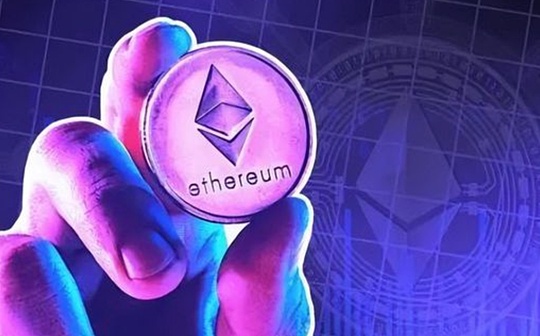
Author: Tanay Ved & Matías Andrade Source: Coin Metrics Translation: Shan Oppa, Bitchain Vision
Key points:
-
Since EIP-4844 was launched on March 13, several Layer-2 solutions, including Arbitrum, Base and Optimism, have adopted blob transactions, with more than 950,000 blobs being published on Ethereum.
-
The adoption of Blobs has significantly reduced the operating costs of Layer-2s, and the median blob fee has been reduced to a minimum of $0.0000000005, making user interaction more affordable.
-
The Blob fee market adjusts dynamically based on demand, like the case where the average number of blobs per block is pushed to Target 3 by subscribing to blobs (“Blobscriptions”), temporarily pushing the fee to $27 and then falling back to nearly $0.
Introduction:
EIP-4844 (joke “original-danksharding”) was launched in March’s Ethereum Dencun upgrade, an important milestone for Ethereum’s rollup-centric roadmap.The upgrade aims to improve the scalability of the Ethereum Layer-2 solution and reduce transaction costs by optimizing how they clear transactions to Ethereum Layer-1.This is achieved by providing dedicated space for “blobs” (fragments of data), which L2 can use to settle transactions more cost-effectively.The ultimate goal is to expand the coverage of the Ethereum ecosystem by making transactions more affordable and scalable.
In this week’s Coin Metrics’ “Network Status” report, we provide a data-driven breakdown of the use of Layer-2 blobs and evaluate the success of Ethereum’s EIP-4844 upgrade.
What are Blobs, sorters, and data availability layers?
As Ethereum matures, it has transformed into a modular blockchain, with various infrastructures working together to achieve its core functionality.Layer-2 forms an infrastructure in the stack of Ethereum, enabling the network to scale.In the past few years, a large number of Layer-2 solutions, such as rollups (such as Base, Optimism, and Arbitrum), have emerged, and several others are still under development.These protocols rely on Layer-1 blockchains like Ethereum for data availability (storing/accessing transaction data) and ensure settlement of transactions through participants known as sorters that sort transactions and submit in batchesGive Ethereum L1.However, for Layer-2s, the costs associated with these operations are still high.
This is where EIP-4844 is used.The upgrade introduces a new type of transaction with blobs, temporary packets that L2s can use for cost-effective settlement.Blobs provides approximately 18 days for L2s to use – unlike calldata that was previously permanently stored in Ethereum blocks.The temporary nature of Blobs allows them to be sold at a cheap price, which significantly reduces the storage and data costs of L2s.
In the previous section, we will understand the impact of EIP-4844 on Ethereum’s L2 ecosystem and its economics.
Adoption of Blob Transactions
Since its launch on March 13, several L2s have begun to use blob transactions, first of which are zkSync, Starknet and Optimism.Since then, more than 950K blobs have been released on Ethereum, with 450K transactions carrying blobs.On average, this is equivalent to 10K blobs per day for most of April, and this number has recently increased to 17K as more Layer-2s enter and adopt blobs.
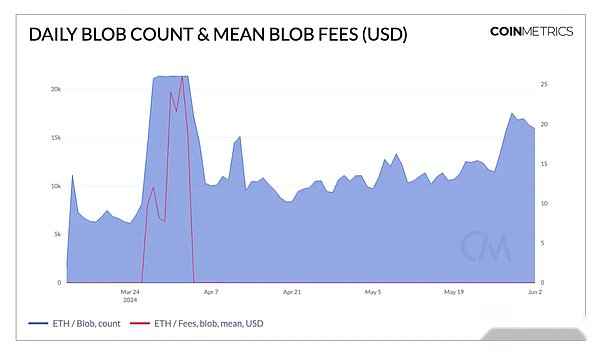
Each transaction carrying a blob can contain up to 6 blobs, each blob stores 128KB of data.As Layer-2 rollups increasingly adopt this dedicated space to publish large amounts of data, the utilization of blob space is expected to increase.So far, a total of 125B bytes of blob space has been used, so the blob size is growing compared to the total block size (in bytes).This shows that L2 is moving from calldata to a more efficient form of data storage.The key is that blobs are designed to expire after 4096 eras (about 18 days), providing rollups with enough time to retrieve the necessary data while preventing permanent storage bloat on the Ethereum network.
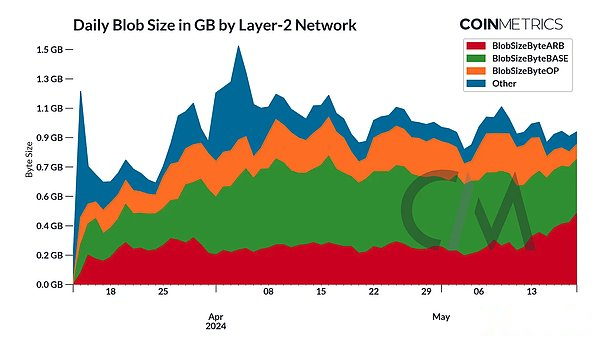
After excluding the influence of inscriptions, Layer-2’s adoption of blob storage and blob transactions is relatively stable.Although Coinbase’s Base maintains the largest portion of blob size and blob transactions, the impact of Arbitrum is significantly enhanced.As the number of rollups increases and the use of blobs is expected to continue to increase.Overall, adoption of blobs is a positive signal that EIP-4844 is achieving its goal of reducing data storage overhead and enhancing the scalability of Layer-2 solutions.

Impact of Blob Fees and Costs
Adopting this efficient storage and transaction type brings significant operating costs to L2’s.When the L2 sorter batches the blob and submits it to Ethereum L1, they incur a fee, which is a cost for L2.Although the weekly fees associated with Arbitrum, Base and Optimism sorters rose to $700K in April due to the surge in inscription blobs, the expenses spent on blob space have been reduced to $0.00002.
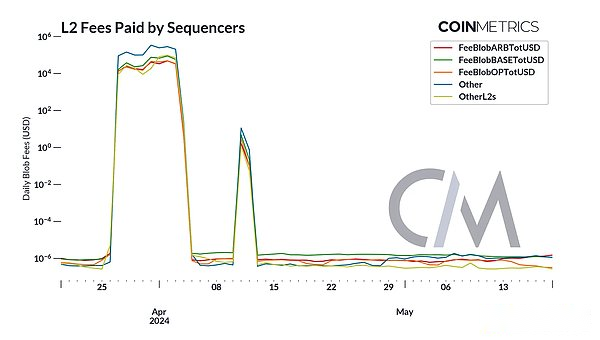
The increased cost efficiency of L2s has been translated into extremely low fees for end users.Currently, the median blob fee is as low as $0.000000005, a sharp drop from the peak of $27, while the total amount of payment for blob space is close to $0.000008.Ultimately, this makes user interactions such as token transfers between wallets, asset exchanges on DEXs, or other smart contract operations more affordable.
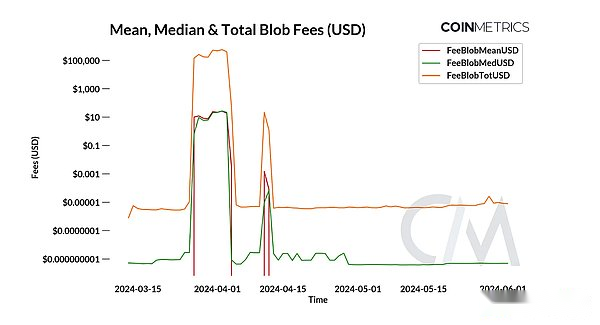
Inscriptions and Blob Cost Market
EIP-4844 introduces a new transaction type and a new fee market for pricing blobs, which is designed to function similar to the fee market for EIP-1559.In this new system, the blob basic expenses are dynamically adjusted according to the supply and demand of the blob space within each block.
The blob pricing mechanism operates according to the following principles:
1. If the number of blobs in a block exceeds the current target 3, the blob basic fee will increase.This is to avoid overuse of blob space and to maintain a balance between supply and demand.
2. If the number of blobs in a block just reaches the target, the blob base fee remains the same.This shows that the supply and demand of the blob space are balanced.
3. If the number of blobs in a block is lower than the target, the underlying blob fee will be reduced.This encourages more use of blob space when it is underutilized.
These price dynamics ensure that the blob fee market can adapt to changes in blob space demand and maintain a stable and efficient fee environment for Layer-2 solutions and users.
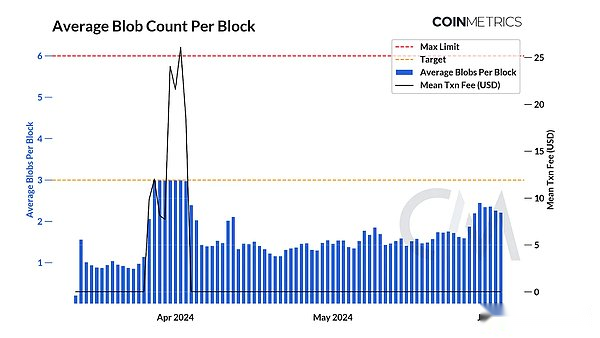
As shown in the above chart, the average daily transaction fee in April increased significantly to $27 as the average number of blobs per block exceeded the target.This increase can be attributed to the surge in inscription blobs (“Blobscriptions”).An inscription is a form of text, images, or other media embedded in a block—or in this case, a blob.From the end of March to the beginning of April, the daily number of blobs with inscriptions rose to a high of 13K, accounting for more than 61% of all blobs.However, since then, the emergence of Blobscriptions has decreased, reducing blob fees back to nearly $0.
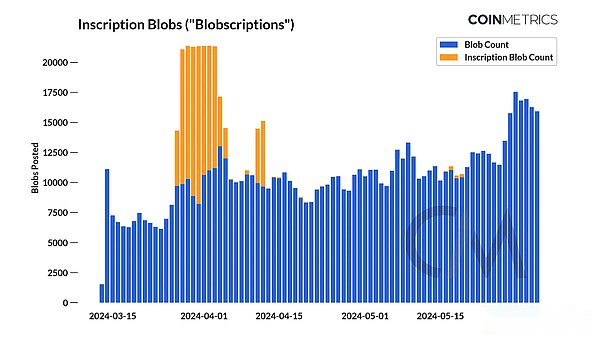
This scenario illustrates how network congestion or high demand for blob space affects blob pricing.While the current blob target for each block may increase in the future, monitoring the above conditions is key to understanding changes in blob fee dynamics, especially as the L2 market continues to expand and become more competitive.Blobscriptions may be just a temporary situation now, but as more L2s utilize blobs to meet their scaling needs, congestion is likely to occur again.
in conclusion
EIP-4844 successfully increased adoption of L2 through blob transactions, reduced Layer-2’s operating costs, and made users’ transaction fees more affordable.However, challenges such as cross-asset, liquidity and user experience fragmentation in Layer-2 solutions, as well as the need for decentralized sequencers, remain.Addressing these issues is critical to the continued growth and success of Ethereum’s Layer-2 ecosystem, making transactions scalable and cost-effective while remaining secure and decentralized.
Network data insights
Summary of the key points
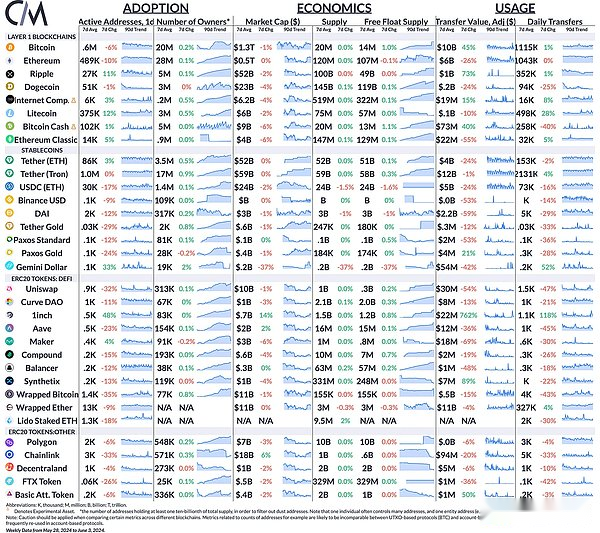
Transfer value on the Bitcoin network (adjusted) increased by 45%, while transfer value on the Ethereum network decreased by 26%.This week, Bitcoin active addresses fell by 6% and Ethereum active addresses fell by 10%.








